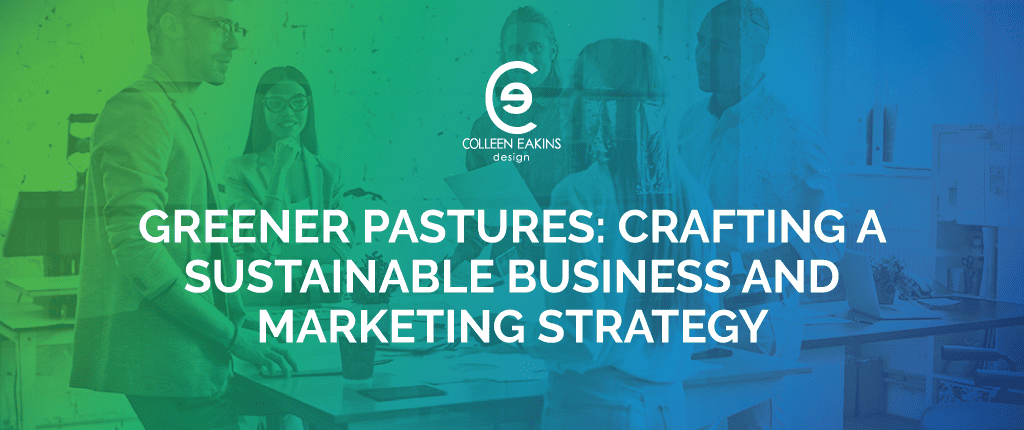Greener Pastures: Crafting a Sustainable Business and Marketing Strategy
In today’s dynamic business landscape, the call for sustainability has transcended from a mere trend to an indispensable facet of entrepreneurship. As consumers become increasingly conscious of the environmental impact of their choices, the demand for eco-friendly products and services has reached new heights. Entrepreneurs are now faced with the imperative task of not only meeting this growing demand but also aligning their businesses with a commitment to environmental responsibility. In this article, the essential steps to build a green business and marketing plan will be elucidated, guiding entrepreneurs on the path to success in a world where sustainability is no longer optional but essential.
Unleash your brand’s potential with the remarkable design expertise of Colleen Eakins Design. Start transforming your ideas into impactful visuals today!
Incorporating Sustainable Practices
The first crucial step in creating a green business plan is integrating sustainable practices into daily operations. This involves eco-friendly processes, reducing environmental impact, and potentially saving costs. Practices like energy efficiency, waste reduction, and responsible material sourcing enhance the business’s eco-conscious reputation.
Selecting Sustainable Suppliers
Selecting suppliers who embrace your sustainability goals is essential for upholding the integrity of your green business. Collaborating with suppliers committed to eco-conscious standards ensures that your supply chain aligns with your environmentally friendly mission, which in turn cultivates a favorable reputation among eco-aware consumers. These partnerships not only reinforce your commitment to sustainability but also serve as an inspiring example for others in your industry to follow.
Streamlining Contracts and Signatures
Streamlining contracts and signatures in your green business plan is a smart move. When it comes to client and vendor contracts, one advantageous approach is to use a free PDF filler, which not only saves time but also reduces paper consumption. This method underscores the efficiency and eco-friendliness of adopting paperless documentation practices. By embracing technology in this way, you can further demonstrate your commitment to a sustainable future while streamlining your operations.
Promoting Eco-Friendly Products and Services
In any green business plan, marketing environmentally conscious products and services is paramount. By employing various marketing strategies, you can draw in eco-conscious consumers actively searching for sustainable options. Utilize your branding, advertising, and packaging to underscore the eco-friendly qualities of your offerings and explore certifications or labels that confirm their sustainability. Successful businesses in this domain often use storytelling to connect with their audience, narrating the positive impact of their green products and services on both the environment and society.
Locating Your Business in a Walkable Area
Opting for a walkable business location not only reduces vehicle reliance for employees and customers but also aligns with a green mission. This choice encourages sustainable transportation modes like walking, biking, and public transit use while fostering community engagement. By selecting an area with a high walk score, entrepreneurs contribute to sustainable urban development and a healthier, eco-conscious lifestyle.
Educating Consumers via Social Media
In the era of social media, platforms such as Facebook, Instagram, and Twitter are potent tools for boosting sustainability awareness. By using these channels effectively, businesses can educate and engage their audience. Share informative and inspiring content about sustainability, eco-friendly practices, and your journey toward a greener future. Encourage followers to join eco-friendly challenges and discussions, fostering a community of like-minded individuals committed to sustainability.
Prioritizing Green Investments
Investing in sustainability is an imperative step in building a green business and marketing plan. Allocate resources to green initiatives that will benefit both your business and the environment in the long term. Such investments may include energy-efficient equipment, waste reduction programs, and employee training in sustainability practices. Prioritizing green investments not only helps reduce your ecological footprint but can also result in cost savings and an enhanced reputation. Customers are increasingly inclined to support businesses that demonstrate a dedication to environmental responsibility.
Developing a sustainable business and marketing strategy is imperative in today’s business landscape. Embracing eco-friendly practices, partnering with sustainable suppliers, digitizing contracts, locating your business in a pedestrian-friendly area, promoting green products, educating consumers through social media, and prioritizing green investments are all crucial steps to steer your business toward a greener future. These actions not only meet consumer demands but also have a positive impact on both the environment and business profitability.
:: Guest Post by Kathleen Carter::
Kathleen Carter enjoys educating her peers and others about Asperger’s Syndrome. Recently, she began writing proudly about how her experiences differ from other people her age. She is so grateful to have the opportunity to write for EducatorLabs.





